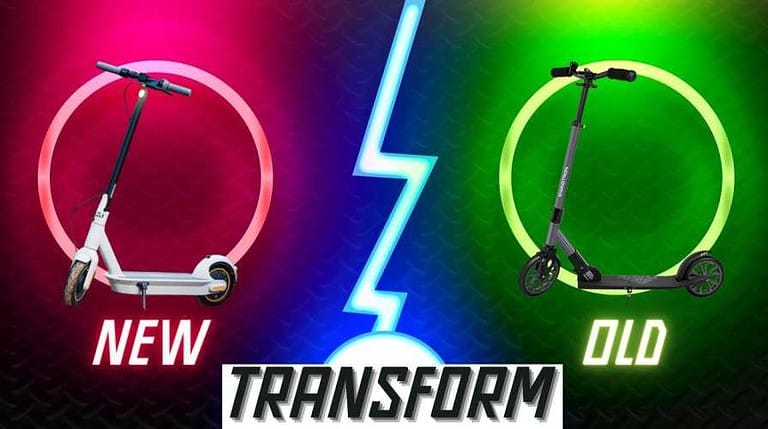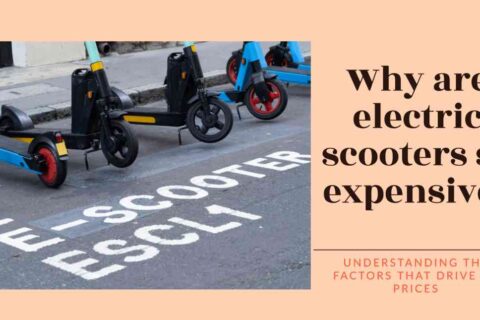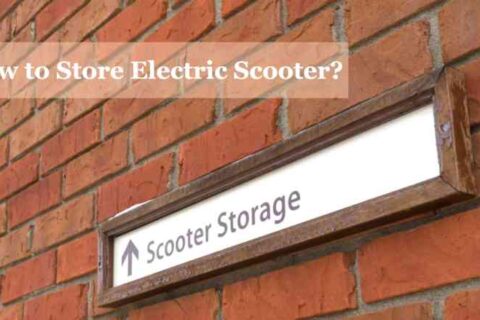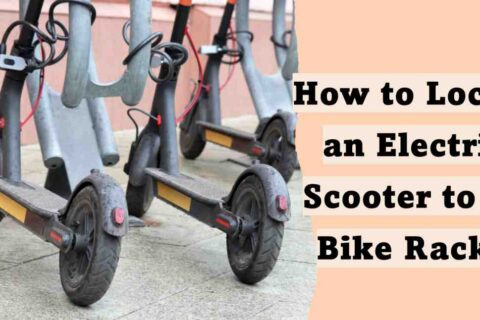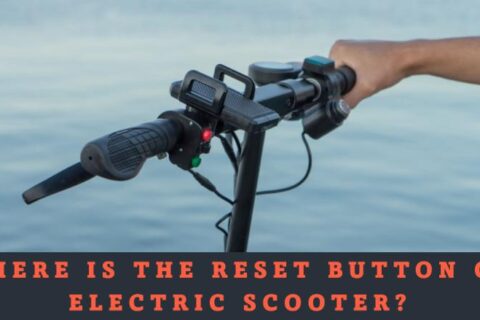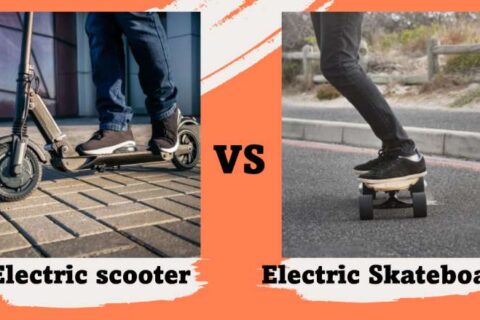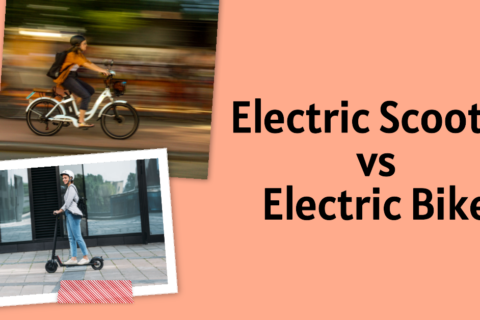Do you know, now a day it’s very common for scooter riders who want to know how to convert kick scooter to electric scooter? Let me guess, you’re one of them, right?
So the process includes upgrading the scooter by adding an electric motor, battery, and other necessary components. This transformation allows riders to enjoy the benefits of an electric scooter while still using their familiar kick scooter frame.
In this article, we will explore the DIY step-by-step process of how to convert kick scooter to electric scooter and highlight the importance and benefits of such a conversion.
Table of Contents
TogglePreparation When Convert Kick Scooter to Electric Scooter
Assessing the feasibility and requirements
Before embarking on the journey to convert kick scooter to electric, it is crucial to assess the feasibility and suitability of the conversion. Consider the following factors first:
- Frame and Structure:
Examine the condition of your kick scooter’s frame and ensure it is structurally sound to handle the additional weight and components to put on for electric conversion. - Weight Capacity:
Determine the weight capacity of your kick scooter and ensure it can support the combined weight of the rider, motor, battery, and other components. - Skill Level and Expertise:
Evaluate your mechanical skills and knowledge of electric systems. To Convert kick scooter to electric scooter requires technical know-how, so be prepared to learn and troubleshoot. You can take a consultant form an expert if possible. It is not rocket science so don’t worry.
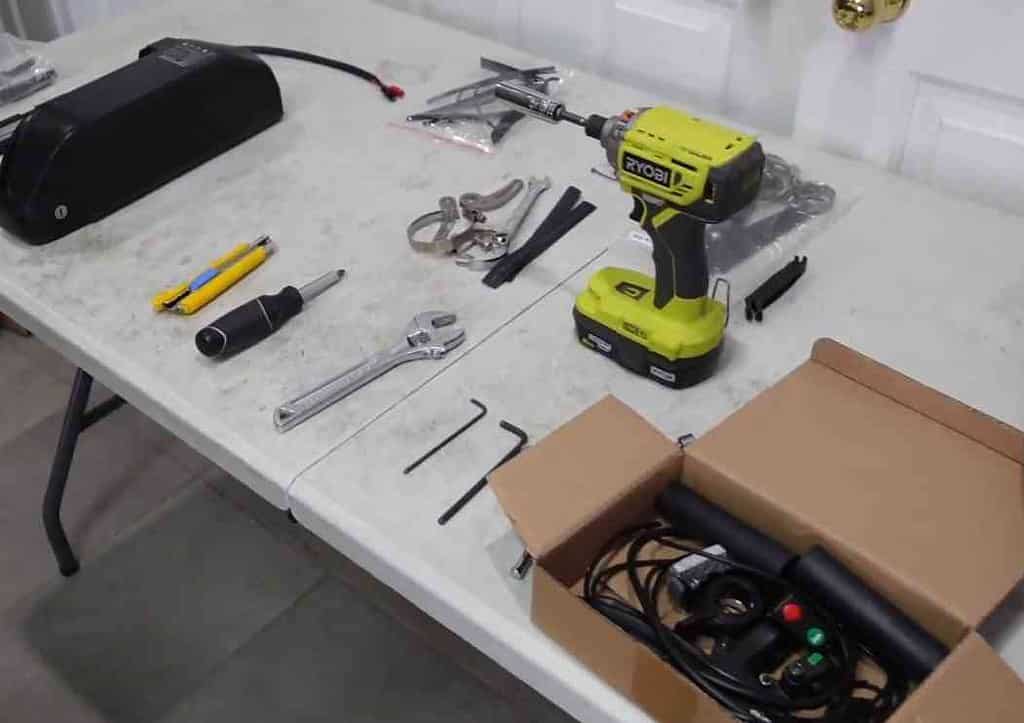
Photo Credit: Golden Motor
Necessary components Required
Proper research is essential to convert kick scooter to electric scooter. It helps you make informed decisions, choose the right components, and understand the conversion process thoroughly.
- Selection of Motors and Batteries:
Conduct thorough research on the various types of electric motors and batteries available in the market. Consider things like power output, voltage, range and compatibility with your kick scooter.
For example, a high-torque brushless motor with a power output of 250-500 watts is suitable for most kick scooters, which provides a good balance between speed and efficiency.
Similarly, lithium-ion batteries of 12V-24V offer longer range and durability compared to lead-acid batteries. - Component Compatibility:
Make sure the selected motor, battery and other components are compatible with your kick scooter’s frame and existing components. Look for conversion kits specifically designed for your scooter model, if available.
It’s crucial to check dimensions, mounting points, and cable connections to ensure a seamless fit.
For example, some conversion kits are designed for specific scooter models, such as the Xiaomi M365 or Razor A5 Lux, providing a simpler installation process. - Quality and Reliability:
Give priority to components known for their quality and reliability. Reading reviews from reputable sources and asking for recommendations from people experienced in the field can help you make an informed decision.
Choosing established brands and suppliers known to produce reliable electric scooter components ensures better performance and longevity for your scooter. - Safety considerations:
Safety should be a top priority when choosing components for your electric scooter conversion. Look for components that comply with safety standards and regulations, and offer features like built-in safeguards and certifications to protect batteries.
For example, choosing a battery with over-charge and short-circuit protection systems reduces the risk of accidents or damage to the scooter. - Tools and Accessories:
Before beginning the conversion process, make a comprehensive list of the tools and accessories needed. This may include wrenches, screwdrivers, cable connectors, mounting brackets, and cable insulators. Check the Accessories quality for a more reliable setup.
DIY Step-by-Step Guide: How to convert kick scooter to electric scooter
Step 1: Disassembling the Kick Scooter
Before proceeding how to convert kick scooter to electric scooter, disassembling the old kick scooter is necessary to prepare the frame for the installation of electric components. Follow these steps:
- Remove the kickstand:
Unbolt or detach the kickstand from the scooter frame using the appropriate tools. - Remove the rear wheel:
Loosen the axle nuts or quick-release mechanism to detach the rear wheel from the scooter frame. - Remove any unnecessary parts:
Take off any additional parts, such as the brake assembly, fenders, or other accessories, that may hinder the conversion process.

Photo Credit: Restore & Rebuild
Step 2: Installing the Motor Mount
The motor mount securely holds the electric motor in place. Here’s how to choose and attach the motor mount:
- Select the appropriate motor mount: Consider the size and compatibility of the motor mount with your chosen electric motor.
- Position the motor mount: Place the motor mount in the desired location on the scooter frame, usually where the rear wheel was attached. May need some customization to attach the motor.
- Align and secure the motor mount: Use bolts, nuts, or clamps to fasten the motor mount securely to the frame. Ensure the mount is aligned properly for the motor installation.

Photo Credit: Restore & Rebuild
Step 3: Attaching the Electric Motor
The electric motor is the heart to convert kick scooter to electric. Here’s how to install it:
- Prepare the motor:
Ensure the motor is free from any packaging materials and protective covers. - Align the motor:
Position the motor onto the motor mount, aligning it with the scooter’s drivetrain. - Secure the motor:
Use bolts or screws to firmly attach the motor to the motor mount. Tighten them appropriately, but avoid overtightening.

Photo Credit: Restore & Rebuild
Step 4: Adjusting Brakes and Handlebars
Proper adjustment of the brakes and handlebars ensures safe and comfortable riding. Follow these steps:
- Brake adjustment: Check the brake assembly and adjust the tension or position as necessary. Ensure the brakes are properly aligned and function effectively.
- Handlebar adjustment: Adjust the handlebars to a comfortable height and position. Tighten the bolts or screws to secure the handlebars in place.

Photo Credit: Restore & Rebuild
Step 5: Installing the Battery
The battery pack powers your electric scooter. Here’s how to attach it:
- Select an appropriate location: Choose a secure and accessible location on the scooter frame to mount the battery pack. The best position could be on the standing deck or the bottom of your scooter handlebar.
- Mount the battery pack: Use mounting brackets, straps, or clamps to attach the battery pack to the frame. Ensure it is stable and well-secured.

Photo Credit: Restore & Rebuild
Step 6: Wiring and Connections
Proper wiring and connections are crucial for the electric scooter’s functionality. Follow these steps:
- Connect the motor: Use appropriate wiring connectors to connect the motor to the battery pack and controller according to the manufacturer’s instructions.
- Connect the controller: Attach the controller to the scooter frame and connect it to the battery pack and motor using wiring connectors.
- Double-check connections: Ensure all wiring connections are secure and properly insulated to avoid any short circuits or loose connections.
Step 7: Testing the Electric Scooter
Testing the electric scooter is essential to ensure its functionality and safety. Perform the following tests:
- Power on the scooter: Turn on the power switch and ensure the battery pack and controller are receiving power.
- Test motor functionality: Gradually apply the throttle and check if the motor engages smoothly and the scooter moves forward.
- Brake test: Check the responsiveness and effectiveness of the brakes to ensure safe stopping.
Testing and Troubleshooting
Evaluating the Scooter’s Performance
After completing the conversion process, it is crucial to evaluate the scooter’s performance to ensure optimal functionality. Here’s how to evaluate the scooter’s performance:
- Test Ride:
Take the scooter for a test ride in a safe and open area. Observe its speed, acceleration, and overall handling. - Assess Speed and Range:
Determine if the scooter achieves the desired speed and covers the expected range based on the selected motor and battery. - Check Battery Life:
Monitor the battery’s performance and ensure it provides adequate power throughout the intended ride duration. - Fine-tuning:
Note any areas for improvement, such as adjusting the motor power, throttle response, or brake sensitivity.
Troubleshooting Common Issues and Solutions
During the testing phase, it is possible to encounter certain issues. Here are some common issues and their potential solutions:
- Motor Not Engaging:
Check the wiring connections between the motor and controller. Ensure they are properly connected and secure.
Verify that the power switch is on and the battery pack has sufficient charge. - Battery Drains Quickly:
Examine the battery connections for loose or faulty wiring. Assess the battery’s capacity and consider upgrading to a higher-capacity battery if necessary.
Check for any components drawing excess power when the scooter is idle. - Brake Issues:
If the brakes are not responsive or lack stopping power, adjust the brake tension or alignment.
Ensure the brake pads are properly aligned with the wheel and make contact when the brake lever is engaged. - Poor Speed or Performance:
Assess the motor power and controller settings. Make sure they are properly configured for the desired speed and performance.
Verify that the motor and battery are compatible and functioning optimally. - Electrical Malfunctions:
Inspect the wiring connections for loose or damaged wires. Check for any signs of short circuits, exposed wiring, or faulty components.
Repair or replace any damaged parts to ensure safe and reliable operation.
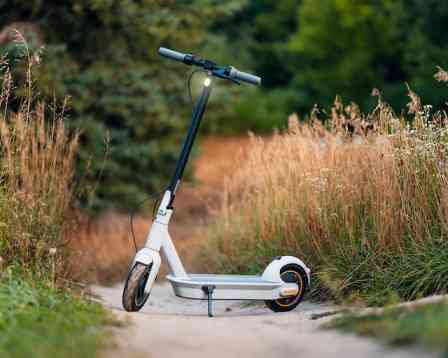
Advantages and Disadvantages To convert kick scooter to electric scooter
Advantages of Electric Scooters
Electric scooters offer unique advantages that cater to riders’ needs for convenience and efficiency. Here are some advantages of electric scooters:
- Motorized Assistance: Electric scooters provide motorized assistance, allowing riders to cover distances effortlessly and reach higher speeds.
- Extended Range: Electric scooters offer longer-range capabilities, thanks to their battery-powered motors, enabling riders to travel greater distances.
- Environmentally Friendly: Electric scooters produce zero emissions during operation, contributing to a cleaner and greener transportation option.
- Enhanced Speed: Electric scooters can reach higher speeds compared to kick scooters, providing a quicker and more efficient mode of transportation.
Disadvantages of Electric Scooters
While electric scooters offer numerous advantages, they also have certain drawbacks. Here are a few disadvantages of electric scooters:
- Cost: To convert kick scooter to electric scooter tend to be more expensive than kick scooters due to the added cost of the electric motor and battery components.
- Charging Time: Electric scooters require charging, which can take several hours depending on the battery capacity, limiting immediate usability.
- Weight and Bulkiness: Electric scooters are typically heavier and bulkier than kick scooters due to the additional components, making them less portable and more challenging to carry.
- Regulatory Restrictions: Some regions have specific regulations or restrictions on the use of electric scooters, such as speed limits or designated riding areas.
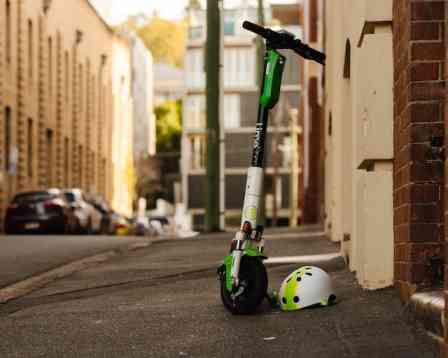
Maintenance and Safety
Regular Inspection and Maintenance
To ensure the longevity and safe operation of your scooter, regular inspection and maintenance are essential. Here’s why it matters:
- Check the Tires:
Inspect the tires for any signs of wear or damage. Ensure they are properly inflated and have sufficient tread depth for optimal grip. - Test the Brakes:
Regularly check the brake system to ensure it is functioning correctly. Adjust the brake tension if necessary and replace worn brake pads. - Assess the Battery:
Monitor the battery’s condition and performance. Keep it clean, properly charged, and stored in a suitable environment as per the manufacturer’s recommendations. - Inspect the Wiring:
Regularly inspect the wiring connections for any signs of damage, loose connections, or exposed wires. Repair or replace any faulty components promptly. - Lubricate Moving Parts:
Apply appropriate lubrication to moving parts such as the wheel axles, folding mechanisms, and steering column to ensure smooth operation.
Importance of Wearing Proper Safety Gear while Riding
Riding any type of scooter safety is first, including electric scooters, requires the use of proper safety gear. Here’s why it’s crucial:
- Head Protection: Wear a well-fitted helmet to protect your head in case of a fall or collision. It can significantly reduce the risk of head injuries.
- Eye Protection: Use goggles or shatterproof glasses to protect your eyes from debris, wind, and insects while riding.
- Body Protection: Wear appropriate clothing, including long pants, closed-toe shoes, and long sleeves, to protect your body from abrasions and impacts.
- Hand Protection: Use gloves to improve your grip on the handlebars and provide protection in case of a fall.
- Visibility: Wear reflective clothing or accessories to enhance your visibility to other road users, especially when riding during low-light conditions.

Can You Revert when you convert kick scooter to electric?
when you convert kick scooter to electric scooter, you might wonder if it’s possible to revert it back to its original state. Here are some important points to consider:
- Permanent Modifications:
To convert kick scooter to electric typically involves permanent modifications, such as removing the kickstand, attaching the motor, and altering the wiring. Reverting back to the original state may require reversing these modifications, which can be challenging or even impossible in some cases. - Compatibility Issues:
Reverting to a kick scooter may face compatibility issues. During the conversion process, original components might have been replaced or modified, making it difficult to find suitable replacements or restore the scooter’s functionality.
The compatibility of the original parts with the modified scooter needs to be carefully considered. - Component Integration:
Some components, like the battery pack and controller, might have been integrated into the scooter’s frame or structure during the conversion.
Removing these components without causing damage or compromising the scooter’s structural integrity might be impractical or unsafe. - Time and Cost:
Reverting back to a kick scooter can involve significant time and cost. It may require purchasing new parts, reassembling the scooter, and potentially seeking professional assistance to ensure proper restoration.
The overall cost and effort involved should be carefully weighed. - Skill and Expertise:
Successfully reverting a converted electric scooter back to its original state requires a good understanding of the conversion process and scooter mechanics.
If you do not possess the necessary skills or knowledge, it may be challenging to restore the scooter properly.
Additionally, here are a few more points to consider when contemplating reverting a converted electric scooter back to its original kick scooter form:
- Availability of Original Parts: Depending on the age and model of your kick scooter, finding the exact original parts that were removed or modified during the conversion process may be challenging. It’s essential to assess the availability and cost of these parts before attempting to revert.
- Skill and Knowledge Required: Reverting a converted electric scooter back to a kick scooter often requires a certain level of expertise. Understanding the scooter’s mechanical and electrical systems, as well as having the necessary tools and skills, is crucial for a successful restoration.
- Warranty and Liability: If your kick scooter was still under warranty before the conversion, it’s important to note that reversing the modifications may void any remaining warranty.
Final Words
When you convert kick scooter to electric scooter that can also be a rewarding project, offering a personalized and eco-friendly transportation option. By following a step-by-step conversion process, which includes assessing feasibility, gathering materials, and performing the necessary modifications, you can transform your kick scooter into an electric-powered vehicle.
Through testing and troubleshooting, you can ensure optimal performance. The conversion provides advantages such as customization, environmental benefits, enhanced performance, and the opportunity for adventure and exploration. Embrace the excitement and enjoy the benefits to convert kick scooter to electric.
Converting a kick scooter to electric scooter is a fulfilling project that requires careful planning, research, and execution. While reverting back to a kick scooter may not always be feasible, embracing the benefits of electric scooter conversion can open up a world of exciting possibilities. Enjoy the journey and embrace the joy of riding your newly convert kick scooter to electric scooter.
Frequently Ask Questions
How fast is a 1000w E-Scooter?
A 1000W electric scooter can reach an average speed of 25–30 mph (40–48 kph), depending on factors such as the rider’s weight and the terrain. The actual top speed may vary.
How fast is a 2000 watt electric scooter?
A 2000W electric scooter can reach speeds of 35-40 mph (56-64 kph) on average. Actual maximum speed may vary based on factors such as rider weight and terrain.
How fast is a 300w electric scooter?
A 300W electric scooter has an average top speed of 15-18 mph (24-29 kph). Actual speed may vary based on factors like rider weight and terrain.
How fast is a 5000W electric scooter?
A 5000W electric scooter can reach impressive speeds of up to 60-70 miles per hour (97-113 kilometers per hour) on average.

